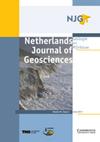Source-bordering aeolian dune formation along the Scheldt River (southern Netherlands – northern Belgium) was caused by Younger Dryas cooling, high river gradient and southwesterly summer winds
IF 2.3
2区 地球科学
Q3 GEOSCIENCES, MULTIDISCIPLINARY
Netherlands Journal of Geosciences-Geologie En Mijnbouw
Pub Date : 2020-11-25
DOI:10.1017/njg.2020.15
引用次数: 5
Abstract
Abstract The Younger Dryas cold period caused major changes in vegetation and depositional environments. This study focuses on the aeolian river-connected dunes along the former, Weichselian Late Glacial, course of the Scheldt River in the southern Netherlands. Aeolian dunes along the Scheldt have received little attention, as they are partly covered by Holocene peat and marine deposits. The spatial distribution of the dunes is reconstructed by digital elevation model analysis and coring transects. Dunes are present on the high eastern bank of the Scheldt and in the subsurface of the polder area west of the Brabantse Wal escarpment. A reach-specific higher channel gradient probably caused a channel pattern change from meandering to braiding during the Younger Dryas. This enabled deflation from the braid plain and accumulation in source-bordering river dunes east of the incised and terraced, subsurface Late Pleistocene Scheldt valley. The age of the dune formation is established by pollen analysis and radiocarbon dating of underlying and overlying peat beds. The peat layer below the dune at Zomerbaan is attributed to the Allerød and early Younger Dryas periods. Dune formation occurred predominantly during the second part of the Younger Dryas stadial, both on and in front (west) of the Brabantse Wal escarpment. Wind direction was reconstructed by geomorphic analysis and sedimentary structures on lacquer peels. A southwesterly wind direction is demonstrated by the parabolic dune morphology. For the first time, Younger Dryas wind direction is reconstructed based on adhesion ripple cross-laminated sets on lacquer peels. Sand-transporting south-southwesterly winds were dominant during the Younger Dryas, most likely during summer.Scheldt河沿岸(荷兰南部-比利时北部)的源缘风成沙丘形成是由新仙女木期降温、高河流坡度和夏季西南风造成的
新仙女木期冷期引起了植被和沉积环境的重大变化。本研究的重点是在荷兰南部的斯海尔德河(Scheldt River)前魏奇塞利亚(Weichselian)晚冰期河道上与风成河流相连的沙丘。斯海尔德沿岸的风成沙丘很少受到关注,因为它们部分被全新世泥炭和海相沉积物覆盖。通过数字高程模型分析和样带取芯,重建了沙丘的空间分布。沙丘分布在斯海尔德河东岸的高地和布拉班斯墙悬崖以西的圩区地下。在新仙女木期,河段特有的较高河道坡度可能导致河道形态由蜿蜒变为辫状。这使得晚更新世斯海尔德河谷下部的切陷阶地以东的辫状平原和与源区接壤的河流沙丘形成了沉积。沙丘形成的年代是通过花粉分析和下伏和上覆泥炭床的放射性碳定年确定的。Zomerbaan沙丘下方的泥炭层形成于Allerød和新仙女木期早期。沙丘的形成主要发生在新仙女木期的第二阶段,在Brabantse岩壁峭壁上和前面(西部)。通过地貌分析和漆皮上的沉积构造重建了风向。抛物状沙丘形态显示为西南风方向。本文首次基于漆皮上的附着纹波交叉层压集重建了新仙女木的风向。在新仙女木期(Younger Dryas),最可能是夏季,携带沙子的西南偏南风占主导地位。
本文章由计算机程序翻译,如有差异,请以英文原文为准。
求助全文
约1分钟内获得全文
求助全文
来源期刊
CiteScore
4.00
自引率
25.90%
发文量
14
审稿时长
>12 weeks
期刊介绍:
Netherlands Journal of Geosciences - Geologie en Mijnbouw is a fully open access journal which publishes papers on all aspects of geoscience, providing they are of international interest and quality. As the official publication of the ''Netherlands Journal of Geosciences'' Foundation the journal publishes new and significant research in geosciences with a regional focus on the Netherlands, the North Sea region and relevant adjacent areas. A wide range of topics within the geosciences are covered in the journal, including "geology, physical geography, geophyics, (geo-)archeology, paleontology, hydro(geo)logy, hydrocarbon exploration, modelling and visualisation."
The journal is a continuation of Geologie and Mijnbouw (published by the Royal Geological and Mining Society of the Netherlands, KNGMG) and Mededelingen Nederlands Instituut voor Toegepaste Geowetenschappen (published by TNO Geological Survey of the Netherlands). The journal is published in full colour.

 求助内容:
求助内容: 应助结果提醒方式:
应助结果提醒方式:


